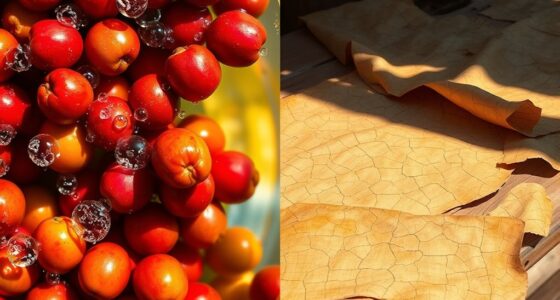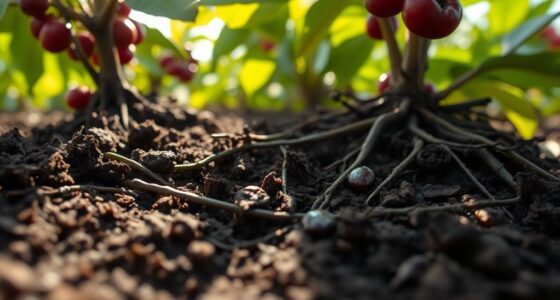Coffee harvesting methods greatly affect taste by determining the quality of the beans you enjoy. Selective picking captures only ripe cherries, enhancing flavor clarity and consistency. In contrast, stripping and machine harvesting mix ripe and unripe cherries, leading to undesirable notes and variable quality. Manual sorting further improves taste by ensuring only the best beans are processed. Understanding these methods helps you appreciate the nuances in your cup of coffee. There’s more to uncover about these practices.
Key Takeaways
- Selective picking enhances flavor clarity by ensuring only ripe cherries are harvested, leading to a more nuanced coffee profile.
- Stripping and machine harvesting mix ripe and unripe cherries, resulting in inconsistent flavor profiles and undesirable notes.
- Manual sorting techniques used in selective picking reduce defects, elevating the overall coffee experience and market value.
- Regular checks during selective picking maintain consistency in flavor quality, unlike the randomness of non-selective methods.
- Sustainable farms that prioritize manual harvesting support ecological preservation while producing superior tasting coffee.
Understanding Coffee Harvesting Methods
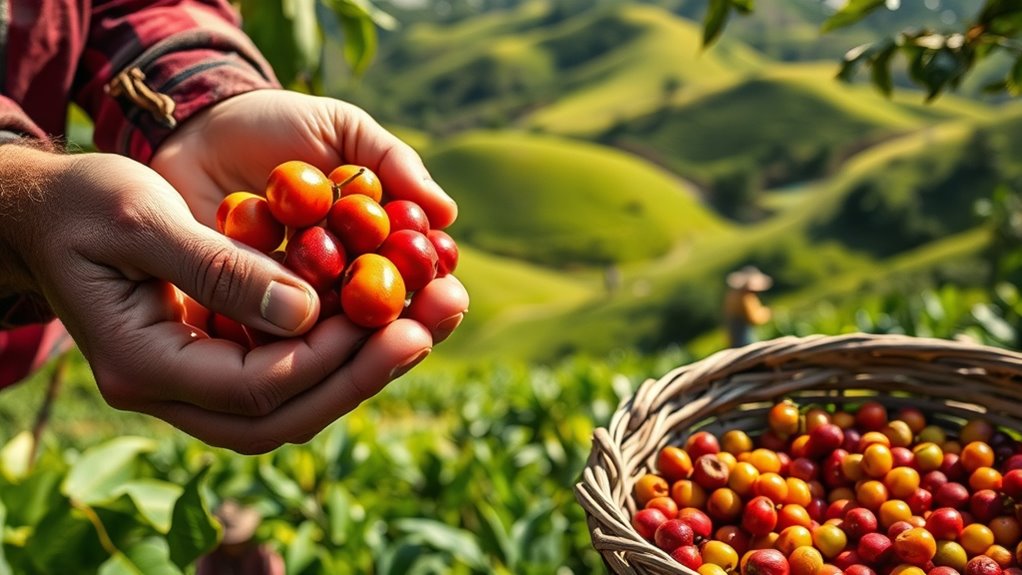
How do different coffee harvesting methods impact the flavor of your cup? The choice of coffee harvesting methods plays an essential role in the quality and flavor profile of your brew.
Selective picking, where only ripe cherries are gathered, guarantees higher quality control, resulting in a richer taste. In contrast, methods like stripping, which collect all cherries at once, often mix ripe with unripe cherries, leading to a less desirable flavor.
While machine harvesting improves efficiency, it frequently causes significant waste of unripe cherries, negatively impacting the final taste. Ultimately, farms that prioritize selective picking tend to produce superior coffee, allowing you to enjoy a more vibrant and nuanced flavor in every sip.
The Importance of Selective Picking

Selective picking is essential for producing high-quality coffee, as it guarantees that only ripe cherries are harvested. This method emphasizes quality over quantity, leading to a more nuanced flavor in your cup. Here’s why selective picking matters:
- Flavor Clarity: By harvesting only ripe cherries, you enhance the coffee’s intrinsic qualities, resulting in a clearer and more vibrant flavor profile.
- Consistency: Checking the fruit condition every 8-10 days assures uniformity in ripeness, which contributes to the overall quality of your brew.
- Reduced Defects: Focusing solely on ripe cherries minimizes the risk of including underdeveloped beans, preventing undesirable sour notes.
Incorporating selective picking into coffee production ultimately elevates your coffee experience, making each sip more enjoyable. Additionally, the commitment to quality through selective harvesting aligns with principles of investment in quality that can lead to better long-term results for producers and consumers alike.
Effects of Strip Harvesting on Quality
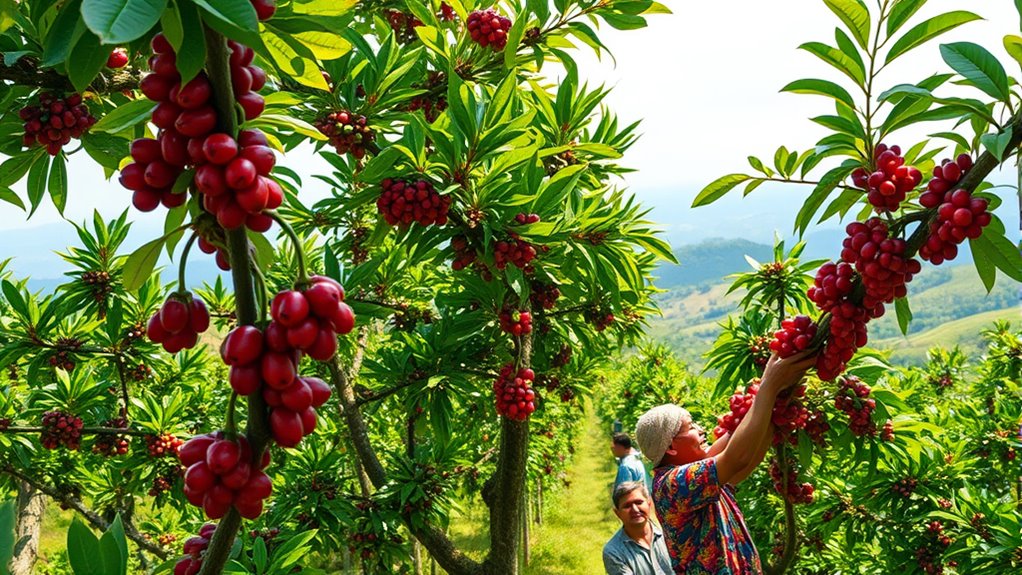
Strip harvesting is a fast and efficient method, but it can seriously compromise the quality of coffee. By removing all coffee cherries simultaneously, you risk mixing ripe cherries with unripe and overripe ones, which negatively affects the overall flavor profile.
The inconsistent quality from this method often leads to undesirable taste notes and an imbalance in the final brew. Unlike selective picking, which focuses on only the best cherries, strip harvesting can result in a higher proportion of defective beans, further detracting from cup quality.
Additionally, the rapid collection of cherries can jeopardize flavor integrity, as any delays in processing may lead to fermentation or spoilage. For superior quality, many farms choose hand-picking to guarantee only fully ripe cherries are used.
Machine Harvesting: Efficiency vs. Quality
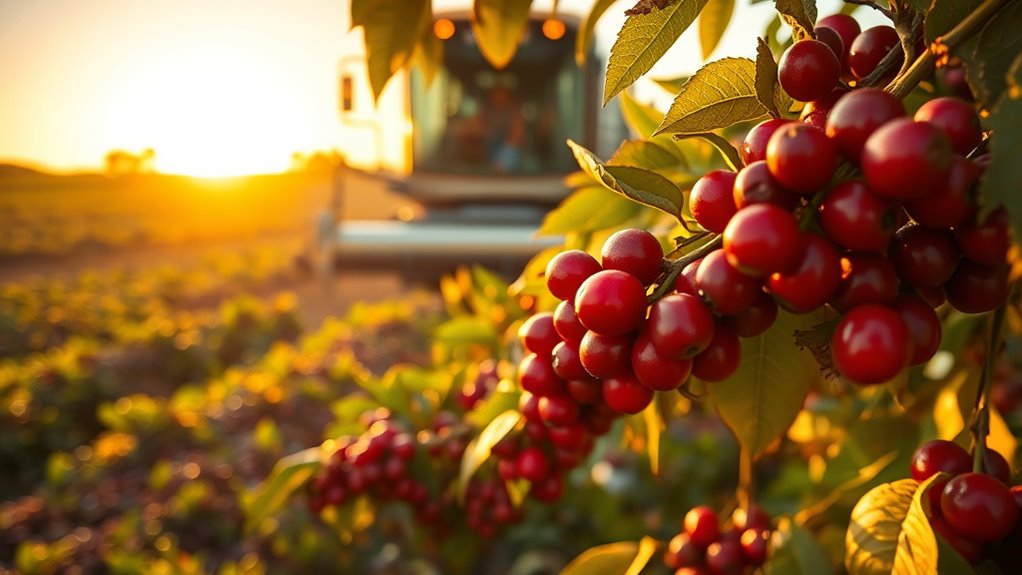
When you consider machine harvesting, you’re looking at a method that boosts speed and efficiency in large coffee plantations.
However, this quick approach often compromises quality, as machines can collect unripe and overripe cherries, impacting the flavor profile.
Balancing cost-effectiveness with the desired quality of your coffee can be a tricky challenge in this method.
Speed of Harvesting
While machine harvesting offers unparalleled speed in collecting coffee cherries, this efficiency comes at a cost. When you rely on machines, you might sacrifice quality for quantity.
Here are three key points to reflect on:
- Selective Picking: Manual picking allows for the careful harvesting of only ripe cherries, ensuring exceptional quality.
- Flavor Profile: Machine harvesting often includes unripe and overripe cherries, compromising the flavor profile and introducing undesirable notes.
- Market Value: The trade-off between speed and quality can lead to lower grading, affecting the market value of your coffee.
Ultimately, while machine harvesting can gather large amounts quickly, it may not yield the premium coffee experience that meticulous manual picking provides.
Quality Control Challenges
Efficiency in machine harvesting may come with significant quality control challenges that can affect your coffee’s overall excellence. While this method is fast, it often leads to a mix of cherry ripeness, compromising flavor profiles and consistency. Unripe cherries can introduce undesirable flavors, making your coffee less enjoyable.
Here’s how machine harvesting stacks up against manual methods:
| Aspect | Machine Harvesting |
|---|---|
| Ripe Cherry Selection | Limited |
| Quality Control | Poor |
| Flavor Consistency | Variable |
| Wastage of Unripe Cherries | High |
| Overall Quality | Compromised |
Collaborating with farms that use manual methods guarantees better quality control, allowing for the careful selection of ripe cherries and enhancing the final product.
Cost-Effectiveness Considerations
Although machine harvesting dramatically speeds up the coffee collection process, it raises important cost-effectiveness questions regarding quality.
You’ll need to take into account:
- Efficiency: Machine harvesting reduces labor costs and processes larger volumes quickly, making it appealing for large-scale operations.
- Flavor Quality: The downside? It often collects unripe cherries, leading to inconsistent flavor profiles that can compromise your coffee’s taste.
- Labor-Intensive Alternatives: Manual picking, while labor-intensive, guarantees only ripe cherries are harvested, resulting in a more uniform and higher-quality coffee.
Ultimately, balancing speed and efficiency with the potential loss in flavor quality is key to determining the best harvesting method for your coffee.
The Role of Ripeness in Flavor Profile
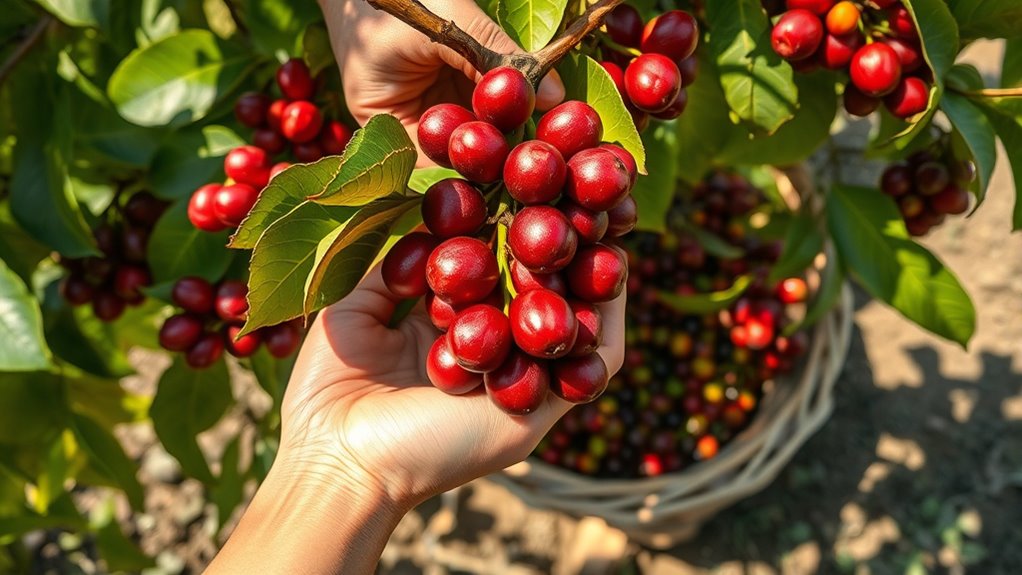
The ripeness of coffee cherries at harvest time plays an essential role in shaping the flavor profile you’ll experience in your cup. Only ripe cherries have the perfect balance of sugars and acidity needed for high-quality coffee.
Harvesting methods, like selective picking, focus on fully ripe cherries, ensuring a superior taste. In contrast, stripping methods that collect unripe cherries can lead to sour and grassy notes that detract from your coffee experience.
Selective picking of ripe cherries enhances flavor, while stripping methods risk sour and grassy notes in your coffee.
Ripe cherries usually bring sweeter and more complex flavors, while unripe cherries introduce harsh elements.
Additionally, the speed between harvest and processing is crucial; timely processing of ripe cherries enhances brightness, while delays can cause fermentation, ruining the intended flavor profile.
Manual Sorting Techniques for Quality Assurance
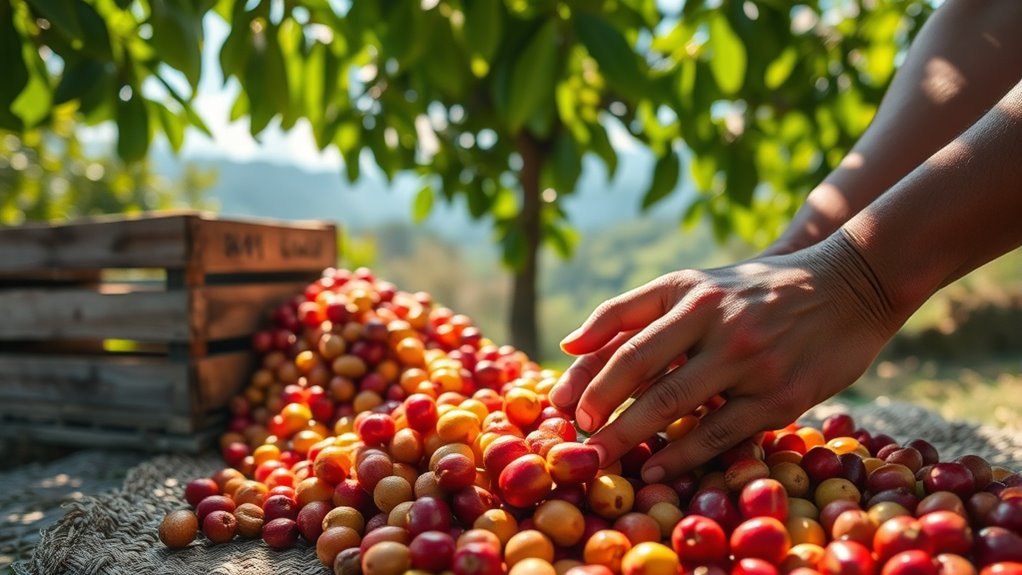
Quality in coffee isn’t just about the beans you pick; it’s also about how you sort them after harvest. Manual sorting techniques are vital for guaranteeing the quality of your coffee. Here’s how it works:
- Handpicking: Experienced workers carefully select coffee beans, eliminating defects based on color, size, and density.
- Sieving: This process guarantees uniformity in size and density, essential for a consistent roasting outcome.
- Flavor Impact: By focusing on the best beans, you enhance the flavor profile of your final product.
Farms that employ these thorough manual sorting techniques, like those in Bali Batur Mountain, demonstrate a commitment to quality, guaranteeing only the finest coffee beans reach consumers and providing job opportunities in local economies.
Harvesting Methods and Their Impact on Sustainability
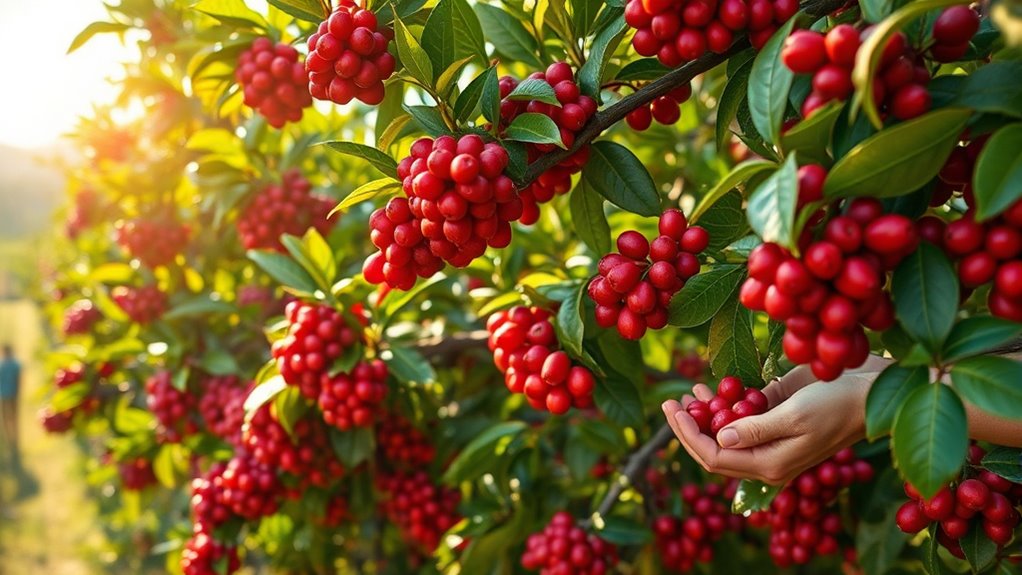
When you consider coffee harvesting methods, it’s crucial to think about their sustainability impact.
Selective picking not only enhances quality but also supports environmental health, while methods like stripping can harm both the crop and the ecosystem.
Sustainable Picking Practices
Sustainable picking practices play a crucial role in enhancing not just the quality of coffee but also its environmental impact. By opting for selective hand-picking, you guarantee that only the ripest cherries are harvested, which leads to superior flavor and minimal waste.
Here are three key benefits of these practices:
- Quality Improvement: Manual picking allows for thorough sorting, reducing defects and elevating the coffee’s taste profile.
- Economic Viability: Farms using sustainable methods yield higher-quality beans, resulting in better market prices for farmers.
- Reduced Environmental Impact: Selective harvesting minimizes machinery use, protecting soil integrity and surrounding ecosystems.
Collaborating with farms prioritizing these methods encourages a commitment to quality and environmental stewardship, benefiting both producers and consumers alike. Additionally, sustainable living practices can significantly enhance the overall appeal of coffee products, attracting a more environmentally conscious consumer base.
Environmental Impact Assessment
Coffee harvesting methods greatly shape the environmental landscape of production, as they directly influence waste levels and overall sustainability.
Manual picking, while labor-intensive, promotes sustainable farming practices by ensuring only ripe cherries are harvested, reducing waste and enhancing quality coffee. In contrast, methods like stripping or machine harvesting often collect unripe and overripe cherries, which can lead to increased waste and lower quality. This negatively impacts the environmental sustainability of coffee production.
Sustainable coffee farms usually prioritize manual harvesting to align their practices with ecological preservation. By focusing on these environmentally friendly methods, you can contribute to a more sustainable future for coffee, ensuring that quality coffee is produced while minimizing environmental degradation.
Labor Considerations in Harvesting
Many factors influence labor considerations in coffee harvesting, and the choice of method plays an essential role. Each method impacts the quality of the coffee and sustainability efforts.
Here are three key considerations:
- Manual Picking: This labor-intensive method guarantees only ripe coffee cherries are harvested, leading to higher quality coffee and promoting sustainable farming practices.
- Stripping: This method removes all cherries at once, often resulting in a mix of ripe and unripe cherries, which can lower quality and sustainability due to wasted resources.
- Machine Harvesting: While fast, this method tends to waste unripe cherries, negatively affecting coffee quality and raising sustainability concerns.
Case Study: Coffee Farms and Their Practices
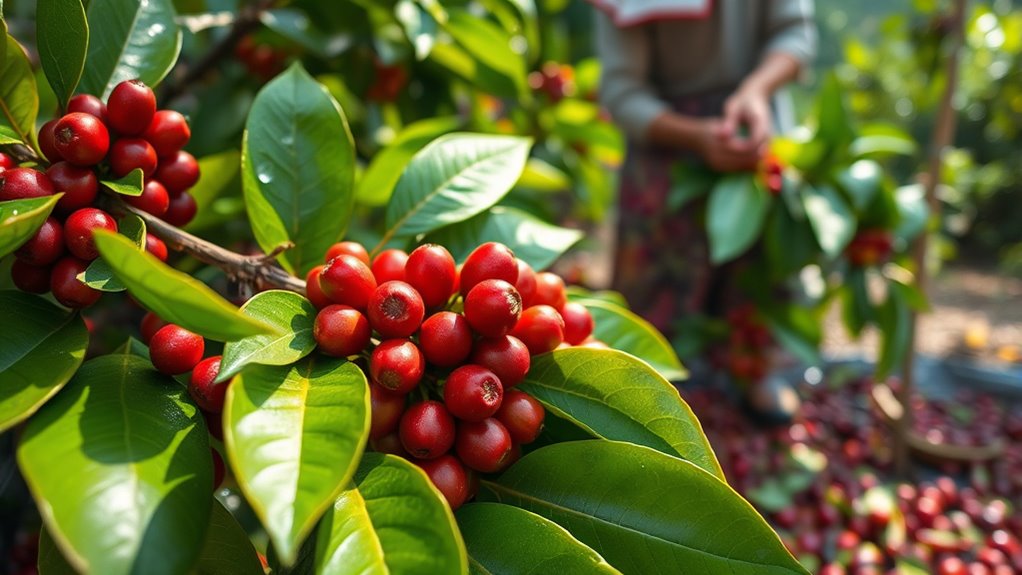
When exploring coffee farms and their practices, you’ll find that different harvesting methods can greatly influence the quality of the final product.
Farms that employ picking, like those in Bali Batur Mountain, Indonesia, prioritize quality by only harvesting ripe cherries. This careful selection guarantees superior beans and a more refined flavor profile.
In addition, manual sorting techniques, such as handpicking and screen sorting, are used to remove defects, enhancing the overall quality and consistency of the coffee.
On the other hand, methods like stripping can lead to a mix of ripe and unripe cherries, negatively impacting flavor.
Collaborating with farms that utilize these selective harvesting methods is crucial for achieving the best taste in your coffee.
Enhancing Flavor Through Careful Harvesting

While the journey from cherry to cup may seem straightforward, the method of harvesting plays an essential role in elevating the flavor of your coffee.
Careful harvesting methods, like selective picking, guarantee you get only the ripest cherries, greatly enhancing the taste and quality.
Here’s how:
- Selective picking allows for only ripe cherries to be harvested, resulting in a well-defined flavor profile.
- Manual picking provides detailed attention to fruit condition, enhancing quality by harvesting cherries every 8-10 days.
- Avoiding stripping prevents a mix of ripe and unripe beans, which can ruin flavor consistency.
Frequently Asked Questions
How Does Coffee Grinder Affect Taste?
Your coffee grinder greatly impacts taste. If you use a blade grinder, you might get uneven particle sizes, leading to inconsistent flavors.
A burr grinder, on the other hand, produces uniform grinds, enhancing taste. The material counts too; ceramic burrs create less heat, preserving flavor compounds, while metal ones can alter flavors.
Finally, grinding just before brewing helps retain those aromatic compounds, ensuring you enjoy a fresher, more flavorful cup of coffee.
How Will the Taste of Coffee Be Affected?
The taste of coffee can be affected by several factors.
You’ll notice that the freshness of the beans plays a key role; stale beans often result in a flat flavor.
Brewing time and temperature are essential too—too hot or too long can lead to bitterness.
Additionally, the grind size impacts extraction; a finer grind might enhance flavor but can also overwhelm your palate.
Experimenting with these elements helps you discover your perfect cup!
What Are the 4 Ways to Taste Coffee?
You can taste coffee in several engaging ways.
First, try cupping, where you steep ground coffee in water to evaluate its aroma and flavor.
Second, use a flavor wheel to identify and articulate the notes you experience.
Third, blind tasting allows you to assess coffee without bias, focusing solely on flavor.
Finally, experiment with different brewing methods, like pour-over or French press, to highlight various flavors and aromas in your coffee.
Enjoy the journey!
How Does Coffee That Is Over Extracted Tend to Taste?
Over-extracted coffee usually tastes bitter and astringent.
When you brew it too long or use excessively hot water, you draw out undesirable compounds that overshadow the coffee’s natural sweetness.
Instead of enjoying a balanced cup, you might find harsh notes that make the experience unpleasant.
Proper extraction is essential for bright, clear flavors, so if you’re tasting bitterness, it’s likely that over-extraction is the culprit behind that uninviting cup.
Conclusion
In the world of coffee, every method of harvesting tells a story that shapes the flavor in your cup. When you sip that rich brew, remember the hands that delicately selected each cherry or the machines that zipped through the fields. Each choice, each technique, dances with the beans’ ripeness, crafting a unique taste experience. So, embrace the journey from tree to table—your love for coffee deepens with every sip, connecting you to the heart of its harvest.




